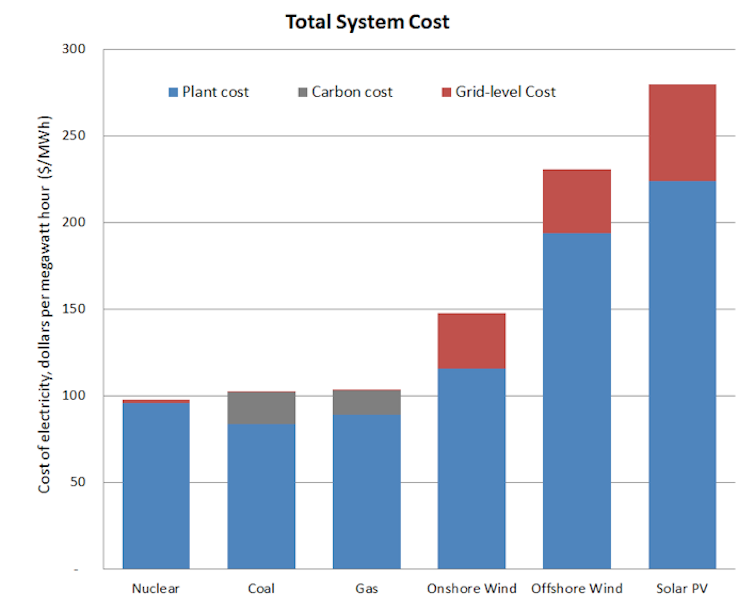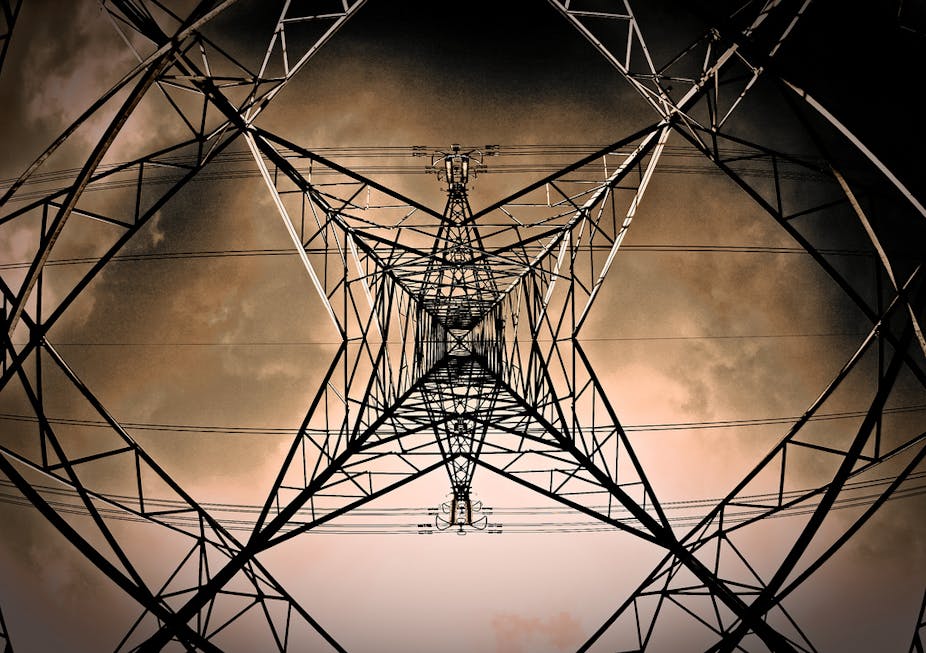A recent Bloomberg press release got wide coverage with its claim that wind power is now cheaper than coal. But a new report from the OECD shows that when you cover the full cost to the grid, variable renewables like wind don’t add up as favourably.
It is often claimed that introducing variable renewable energy resources such as solar and wind into the electricity network comes with some extra cost penalties, due to “system effects”. These system effects include intermittent electricity access, network congestion, instability, environmental impacts, and security of supply.
Now a new report from the OECD titled System Effects of Low-Carbon Electricity Systems gives some hard dollar values for these additional imposts. The OECD work focuses on nuclear power, coal, gas, and renewables such as wind and solar. Their conclusion is that grid-level system costs can have significant impacts on the total cost of delivered electricity for some power-generation technologies.
All generation technologies cause system effects to some degree. They are all connected to the same transmission and distribution grid structure and deliver electricity into the same market. They also exert impacts on each other, on the total load available to satisfy demand, and the stability of the grid’s frequency control. These dependencies are heightened by the fact that only small amounts of cost-efficient electricity storage are available.
Any electricity generation technology can cause grid instability and price fluctuations if it goes offline unexpectedly. But a key finding of the OECD report is that renewables that are particularly variable, such as wind and solar, generate system effects that are at least an order of magnitude greater than for “dispatchable” technologies such as coal, gas, and nuclear.
These renewable sources require no fuel, and so have very low operating costs. This allows them to enter the market at low prices (or even negative prices if production subsidies or generation mandates are in place).
As a consequence, with the current power-generation mix in the OECD (including Australia), dispatchable technologies will suffer due to lower average electricity prices and reduced capacity factors when a significant quantity of low-cost renewable energy is available. (That is, dispatchable units will more often be forced to ramp down their output when there are high flows of low-cost renewable energy, yet will still need to be ready to ramp up again when the output from variable renewable generators is not sufficient to meet the total demand across the grid.)
The report defines grid-level system costs as the total costs (on top of plant-level costs) to supply electricity at a given load and given level of security of supply. These additional costs include the extra investment to extend and reinforce the grid, plus the costs for increased short-term balancing and for maintaining the long-term adequacy of electricity supply in the face of intermittent variable renewables.
The system costs are limited to costs that accrue within the electricity system, so environmental and long-term security of supply impacts are excluded from this study.
The study assessed the grid-level system costs for six OECD countries with contrasting mixes of electricity technologies: Finland, France, Germany, South Korea, the United Kingdom and the United States. System costs, which include short-term balancing, long-term adequacy, and the costs of various grid infrastructures, were calculated at both 10% and 30% penetration levels of the main generating sources.
A summary of the results, expressed in dollars per megawatt hour ($/MWh) of electricity delivered, is shown in Table 1 below. The table shows the lowest and highest system costs for each technology considered at each penetration level.

The consequences of these results are clear. Grid-level system costs can be significant, particularly for wind and solar, and must be included in any realistic analysis of the total system costs of all technologies deployed at scale in regional or national electricity markets.
For Australia, the Bureau of Resources and Energy Economics (BREE) in its AETA report sets out the Levelised Cost of Electricity (LCOE) for each technology, with and without a carbon price. However the bureau does not consider grid-level system costs. The levelised cost reflects the minimum cost of energy at which a generator must sell the produced electricity in order to break even.
If we take the mid-point of the OECD grid-level costs for 30% technology penetration shown in Table 1 and add them to the plant costs and carbon costs from the bureau, we can make a more accurate comparison of the total system costs for each technology as might apply in the Australian context – see Figure 1.

Ignoring such costs distorts the picture. For example, Bloomberg New Energy Finance (BNEF) recently put out a press release headed “Renewable Energy Now Cheaper Than New Fossil Fuels in Australia”, which attracted a great deal of attention.
Bloomberg’s very high coal levelised cost ($143) and lower on-shore wind levelised cost ($80) were the primary reasons for the headline, as pointed out by Tristan Edis at Climate Spectator.
However, if we include the grid-level system cost for wind and solar as estimated in the OECD study and apply the arguably more authoritative levelised costs presented by the bureau (shown in Figure 1), then the Bloomberg headline seems unlikely to be correct.
Like the carbon price, grid-level system costs need to be internalised. In other words, the plant owner should have to pay for grid-level costs in the same way they pay for carbon emissions. That way, solar and wind bid prices into the national electricity market would need to include the grid-level costs and could no longer be bid at rock bottom levels. This would help to level the playing field with coal and gas (important for the future viability of carbon-capture-and-storage technologies), and allow for a realistic assessment of the financial viability of nuclear energy for Australia.
In particular, if the Australian Energy Market Operator is to make a fully costed assessment, it must include grid-level costs in its forthcoming 100 per cent Renewable Study.
This article was co-authored by Martin Nicholson. Martin is an independent researcher who recently published a peer-reviewed book The Power Maker’s Challenge.

